(PDF) Effects of gender on work-related attitudes
81 Pages16555 Words30 Views
Added on 2021-04-21
(PDF) Effects of gender on work-related attitudes
Added on 2021-04-21
ShareRelated Documents
Running head: DISSERTATION
Cardiff Metropolitan University
Cardiff School of Management
MBA
Impact of Attitude Towards Lean Management On the Job Satisfaction Level of a
Merchandiser- Case Study of Linea Aqua, Sri Lanka
Submitted in May 2018
By
[Your Name]
(Student ID - [your University ID] – [ICBT Id])
This dissertation is submitted in partial fulfillment of the requirements for the degree of
Master of Business Administration (MBA)
Cardiff Metropolitan University
Cardiff School of Management
MBA
Impact of Attitude Towards Lean Management On the Job Satisfaction Level of a
Merchandiser- Case Study of Linea Aqua, Sri Lanka
Submitted in May 2018
By
[Your Name]
(Student ID - [your University ID] – [ICBT Id])
This dissertation is submitted in partial fulfillment of the requirements for the degree of
Master of Business Administration (MBA)
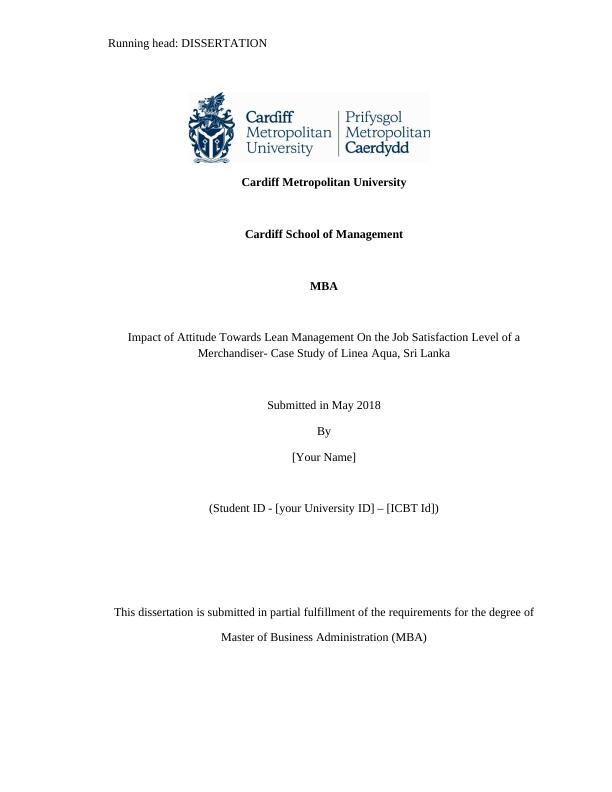
1DISSERTATION
DECLARATION
This work is being submitted in partial fulfillment of the requirements for the degree of
.......................................................................................................and
has not previously been accepted in substance for any degree and is not being
concurrently submitted in candidature for any degree.
Signed ............................................................ (Candidate) Date
- ...................................
SUPERVISOR’S DECLARATION STATEMENT
Student Name – Supervisor’s Name -
I acknowledge that the above named student has regularly attended the meeting, and
actively engaged in the dissertation supervision process.
Signed - .................................................... (Supervisor) Date -
...........................
DECLARATION
This work is being submitted in partial fulfillment of the requirements for the degree of
.......................................................................................................and
has not previously been accepted in substance for any degree and is not being
concurrently submitted in candidature for any degree.
Signed ............................................................ (Candidate) Date
- ...................................
SUPERVISOR’S DECLARATION STATEMENT
Student Name – Supervisor’s Name -
I acknowledge that the above named student has regularly attended the meeting, and
actively engaged in the dissertation supervision process.
Signed - .................................................... (Supervisor) Date -
...........................
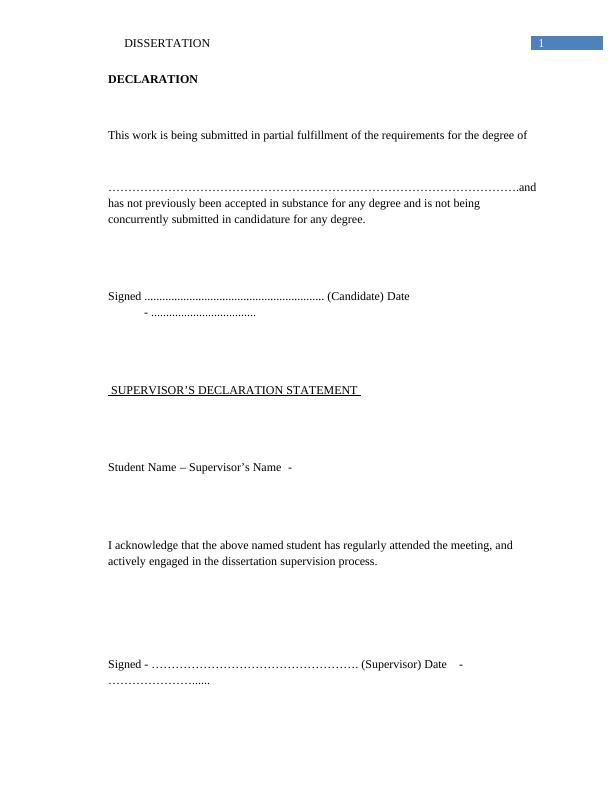
2DISSERTATION
Abstract
This research has focused on lean management by Linea Aqua so that it can help in
increasing the level of job satisfaction among the high-end merchandisers. The first
chapter contains the meaning and a brief introduction regarding lean management and the
purposes for what it is used. The question and aim of the research has also been provided
in the first chapter. The second chapter deals with the various literature that is available
regarding the lean management system and the benefit that the process carries within
various industries. It provides an overview of the factors that are established by the
previous authors so that the research can be conducted in a proper manner. The third
chapter uses the processes that need to be followed by the researcher so that it can help
him in conducting the process in an effective manner. The use of the analytical tools that
is available will help the researcher in giving a proper shape to the research. The fourth
chapter consists of the analysis and the findings that has proved the impact of lean
management on the satisfaction level of the merchandisers so that they can work in a
better manner within the organization. The analysis has helped in establishing the
objectives that has been taken up in the research so that finite conclusions can be reached.
The fifth chapter provides the recommendations for the organization so that it can adopt
the methods, which will help in decreasing the waste of the organization and increasing
the level of satisfaction among the merchandisers as well.
Abstract
This research has focused on lean management by Linea Aqua so that it can help in
increasing the level of job satisfaction among the high-end merchandisers. The first
chapter contains the meaning and a brief introduction regarding lean management and the
purposes for what it is used. The question and aim of the research has also been provided
in the first chapter. The second chapter deals with the various literature that is available
regarding the lean management system and the benefit that the process carries within
various industries. It provides an overview of the factors that are established by the
previous authors so that the research can be conducted in a proper manner. The third
chapter uses the processes that need to be followed by the researcher so that it can help
him in conducting the process in an effective manner. The use of the analytical tools that
is available will help the researcher in giving a proper shape to the research. The fourth
chapter consists of the analysis and the findings that has proved the impact of lean
management on the satisfaction level of the merchandisers so that they can work in a
better manner within the organization. The analysis has helped in establishing the
objectives that has been taken up in the research so that finite conclusions can be reached.
The fifth chapter provides the recommendations for the organization so that it can adopt
the methods, which will help in decreasing the waste of the organization and increasing
the level of satisfaction among the merchandisers as well.

3DISSERTATION
Acknowledgement
I would also like to take this opportunity to thank my professor without whose, constant
support and guidance, the research would not have been possible.
Firstly, I would like to thank God the Almighty in giving me the strength and courage
without which I could not have completed the entire study. Secondly, I would like to
thank my family and relatives who gave me constant support mentally and physically so
that I can complete the study on time. Lastly, I would like to give thanks to my peers and
the friends who have helped me in providing the appropriate information throughout the
project and helped me in doing the in-depth analysis of the research. Without their proper
guidance, it is impossible for me to complete the project.
Thanks and Regards,
Yours Sincerely,
Acknowledgement
I would also like to take this opportunity to thank my professor without whose, constant
support and guidance, the research would not have been possible.
Firstly, I would like to thank God the Almighty in giving me the strength and courage
without which I could not have completed the entire study. Secondly, I would like to
thank my family and relatives who gave me constant support mentally and physically so
that I can complete the study on time. Lastly, I would like to give thanks to my peers and
the friends who have helped me in providing the appropriate information throughout the
project and helped me in doing the in-depth analysis of the research. Without their proper
guidance, it is impossible for me to complete the project.
Thanks and Regards,
Yours Sincerely,
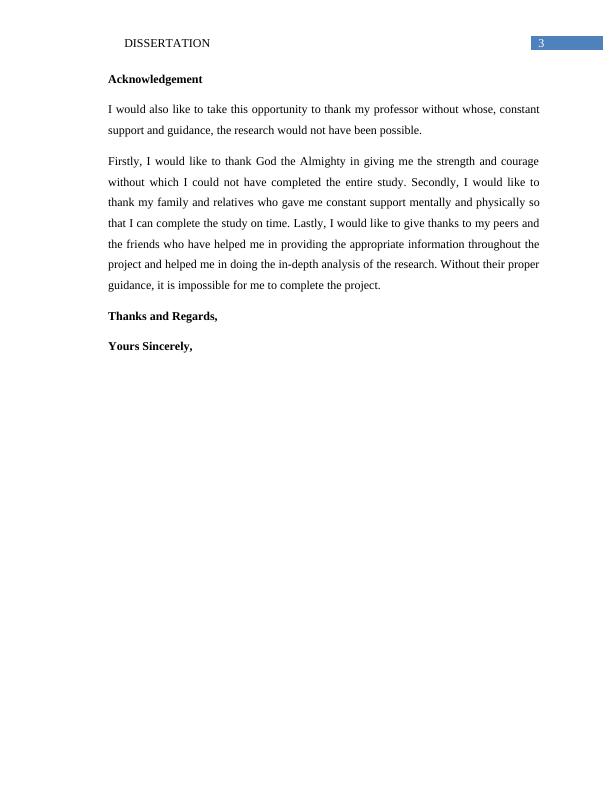
4DISSERTATION
Table of Contents
Chapter 1: Introduction........................................................................................................6
1.1 Background of Study.................................................................................................6
1.2 Research Problem Identification................................................................................7
Symptoms of the Problem...........................................................................................7
Justification of the problem.........................................................................................7
Defining Research Problem.........................................................................................8
1.3 Research Question.....................................................................................................9
1.4 Objectives of the Study..............................................................................................9
1.5 Significance of the Study.........................................................................................10
1.6 Limitation of the Study............................................................................................10
1.7 Chapter Outline........................................................................................................11
Chapter 2: Literature Review.............................................................................................12
2.1. Introduction.............................................................................................................12
2.2. Changing Attitudes Through Motivation................................................................12
2.3. Level of the Training and Changing Attitudes of Employees................................14
2.4. Job Specific Procedures and Attitudes...................................................................14
2.5. Attitudes through Appropriate Structure and The Technology..............................16
2.6. Affecting Organization Culture and Leadership.....................................................16
2.7. Changing Attitudes of Employees..........................................................................19
Chapter 3: Research Methodology....................................................................................22
3.1 Conceptual Framework of the research...................................................................22
3.2 Development of Hypotheses (Optional)..................................................................22
3.3 Operationalization....................................................................................................22
3.4 Research Design......................................................................................................24
Table of Contents
Chapter 1: Introduction........................................................................................................6
1.1 Background of Study.................................................................................................6
1.2 Research Problem Identification................................................................................7
Symptoms of the Problem...........................................................................................7
Justification of the problem.........................................................................................7
Defining Research Problem.........................................................................................8
1.3 Research Question.....................................................................................................9
1.4 Objectives of the Study..............................................................................................9
1.5 Significance of the Study.........................................................................................10
1.6 Limitation of the Study............................................................................................10
1.7 Chapter Outline........................................................................................................11
Chapter 2: Literature Review.............................................................................................12
2.1. Introduction.............................................................................................................12
2.2. Changing Attitudes Through Motivation................................................................12
2.3. Level of the Training and Changing Attitudes of Employees................................14
2.4. Job Specific Procedures and Attitudes...................................................................14
2.5. Attitudes through Appropriate Structure and The Technology..............................16
2.6. Affecting Organization Culture and Leadership.....................................................16
2.7. Changing Attitudes of Employees..........................................................................19
Chapter 3: Research Methodology....................................................................................22
3.1 Conceptual Framework of the research...................................................................22
3.2 Development of Hypotheses (Optional)..................................................................22
3.3 Operationalization....................................................................................................22
3.4 Research Design......................................................................................................24
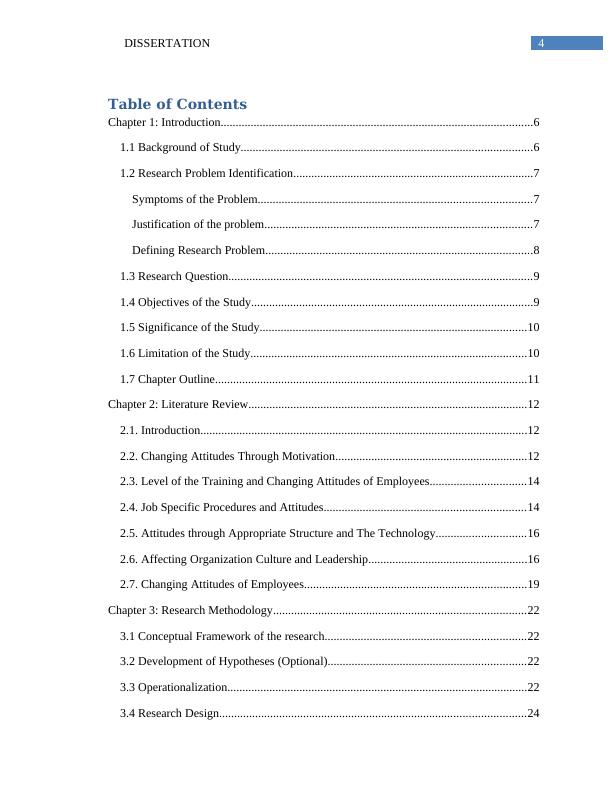
5DISSERTATION
Sampling Design........................................................................................................24
Population..................................................................................................................25
Sample Selection procedure......................................................................................25
Sample Size...............................................................................................................25
Data Collection Method and Techniques Used for Research Analysis.....................25
Chapter 4: Data Presentation and Analysis.......................................................................27
Chapter 5: Conclusion and Recommendations..................................................................64
5.1 Summary of the Study.............................................................................................64
5.2 Conclusion of the Study...........................................................................................64
5.3 Recommendations...............................................................................................67
5.4 Suggestion for Further Research.........................................................................68
Reference List....................................................................................................................70
Appendices........................................................................................................................73
Appendix 1: Survey Questions......................................................................................73
Appendix 2.....................................................................................................................75
Appendix 3: Ethics Form...................................................................................................75
Sampling Design........................................................................................................24
Population..................................................................................................................25
Sample Selection procedure......................................................................................25
Sample Size...............................................................................................................25
Data Collection Method and Techniques Used for Research Analysis.....................25
Chapter 4: Data Presentation and Analysis.......................................................................27
Chapter 5: Conclusion and Recommendations..................................................................64
5.1 Summary of the Study.............................................................................................64
5.2 Conclusion of the Study...........................................................................................64
5.3 Recommendations...............................................................................................67
5.4 Suggestion for Further Research.........................................................................68
Reference List....................................................................................................................70
Appendices........................................................................................................................73
Appendix 1: Survey Questions......................................................................................73
Appendix 2.....................................................................................................................75
Appendix 3: Ethics Form...................................................................................................75
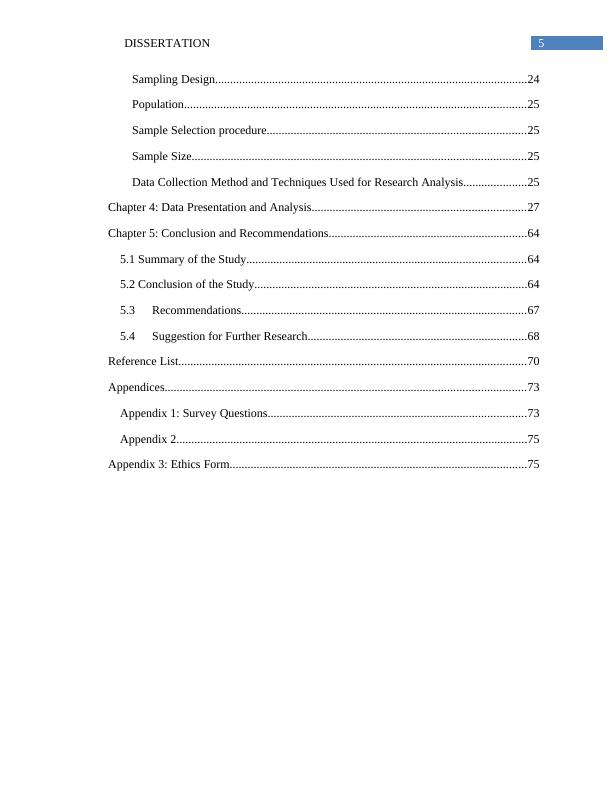
6DISSERTATION
Chapter 1: Introduction
Today, none of the business will be able to survive without receiving the
competitive advantage and the economies of scale in the particular business due to
growing market rivalry. Therefore, visualization of problems and productivity
improvement are some of the key areas to sustain and enhance the business activities
while minimizing the costs of the business. Lean production is one of the systematic
approaches where it helps to enhance the management process of the organization based
on particular concepts through continued improvement, while improving the quality of
the process of manufacturing itself (Rodríguez et al. 2016).
According to the present global context, in the time value of money, the Lean will
help to increase the potential of earning capacity by reducing the waste time which helps
to produce at lowest average cost and boost the demand for the particular product or the
service.
As per the Lean manufacturing process, it is mainly based on “Kaizen”, which is
emphasized “Kai” as change and “Zen” as good, with continued improvement of the
process. However, other than the manufacturing process, it is applied into many fields
such as cross - functional organizational boundaries related to supply chain management
(SCM) and merchandising (Bhamu and Singh Sangwan 2014). Further to that, Kaizen
would be able to be enhanced by TQC (total quality control), where it is correlated with
the Lean process.
1.1 Background of Study
Merchandisers are one of the key stakeholders in the entire business process and
responsible for the interface between buyer and producer or the exporter based on the
nature of the business (Marin-Garcia and Bonavia 2015). Rendering to the value stream
mapping process, it is one of the significant methods of Lean management process where
it will bring more benefits in value chain of the apparel manufacturing sector due to its
market rivals (Hasle 2014).
Chapter 1: Introduction
Today, none of the business will be able to survive without receiving the
competitive advantage and the economies of scale in the particular business due to
growing market rivalry. Therefore, visualization of problems and productivity
improvement are some of the key areas to sustain and enhance the business activities
while minimizing the costs of the business. Lean production is one of the systematic
approaches where it helps to enhance the management process of the organization based
on particular concepts through continued improvement, while improving the quality of
the process of manufacturing itself (Rodríguez et al. 2016).
According to the present global context, in the time value of money, the Lean will
help to increase the potential of earning capacity by reducing the waste time which helps
to produce at lowest average cost and boost the demand for the particular product or the
service.
As per the Lean manufacturing process, it is mainly based on “Kaizen”, which is
emphasized “Kai” as change and “Zen” as good, with continued improvement of the
process. However, other than the manufacturing process, it is applied into many fields
such as cross - functional organizational boundaries related to supply chain management
(SCM) and merchandising (Bhamu and Singh Sangwan 2014). Further to that, Kaizen
would be able to be enhanced by TQC (total quality control), where it is correlated with
the Lean process.
1.1 Background of Study
Merchandisers are one of the key stakeholders in the entire business process and
responsible for the interface between buyer and producer or the exporter based on the
nature of the business (Marin-Garcia and Bonavia 2015). Rendering to the value stream
mapping process, it is one of the significant methods of Lean management process where
it will bring more benefits in value chain of the apparel manufacturing sector due to its
market rivals (Hasle 2014).

7DISSERTATION
Based on the role of the merchandiser, should ensure that product will be reached
at the correct time and the correct place cost effectively. Therefore, a Lean method would
help to mitigate the cost and the time where it will enhance the supply chain management
process (SCM) with the highest customer satisfaction while developing the brand image
of the business (Hasle 2014).
Further, merchandisers will be able to design the appropriate process with
lowering the resources where it helps to enhance the profitability of the business
pertaining to the delivery time and the average cost of the business (Fullerton, Kennedy
and Widener 2014). However, according to the role of the Merchandisers, understanding
the stage of preproduction, application of Lean, minimising phases will help to increase
the marginal returns as per the particular method of production in the long run with
optimisation the profits of the business (Handel 2014). Therefore, identifying the areas of
wasting and applying the precautions through Lean would help to enhance the
productivity of the business as per the strategic plan of the organisation (De Koeijer,
Paauwe and Huijsman 2014). Generally, Sigma is one of the mathematical terms used for
continuous improvements through the process of the business, where it was first
introduced by Motorola in the year 1986 and it is also similar to Kaizen as per Bill Smith
of Motorola Solutions for communication in the USA (Marin-Garcia and Bonavia 2015).
Although, it is mainly based on increasing efficiency of the entire process
together for improving quality of the final product as per identification defect areas of the
system while understanding the appropriate sigma for the particular business area without
applying in general.
1.2 Research Problem Identification
Symptoms of the Problem
According to the apparel industry, it is significantly complex and there are more
competitive business areas due to fewer reasons such as product quality, costs of the
production, delivery times and maintaining the brand image of the business which is
highly collaborated with the process of the business (Handel 2014).
Based on the role of the merchandiser, should ensure that product will be reached
at the correct time and the correct place cost effectively. Therefore, a Lean method would
help to mitigate the cost and the time where it will enhance the supply chain management
process (SCM) with the highest customer satisfaction while developing the brand image
of the business (Hasle 2014).
Further, merchandisers will be able to design the appropriate process with
lowering the resources where it helps to enhance the profitability of the business
pertaining to the delivery time and the average cost of the business (Fullerton, Kennedy
and Widener 2014). However, according to the role of the Merchandisers, understanding
the stage of preproduction, application of Lean, minimising phases will help to increase
the marginal returns as per the particular method of production in the long run with
optimisation the profits of the business (Handel 2014). Therefore, identifying the areas of
wasting and applying the precautions through Lean would help to enhance the
productivity of the business as per the strategic plan of the organisation (De Koeijer,
Paauwe and Huijsman 2014). Generally, Sigma is one of the mathematical terms used for
continuous improvements through the process of the business, where it was first
introduced by Motorola in the year 1986 and it is also similar to Kaizen as per Bill Smith
of Motorola Solutions for communication in the USA (Marin-Garcia and Bonavia 2015).
Although, it is mainly based on increasing efficiency of the entire process
together for improving quality of the final product as per identification defect areas of the
system while understanding the appropriate sigma for the particular business area without
applying in general.
1.2 Research Problem Identification
Symptoms of the Problem
According to the apparel industry, it is significantly complex and there are more
competitive business areas due to fewer reasons such as product quality, costs of the
production, delivery times and maintaining the brand image of the business which is
highly collaborated with the process of the business (Handel 2014).
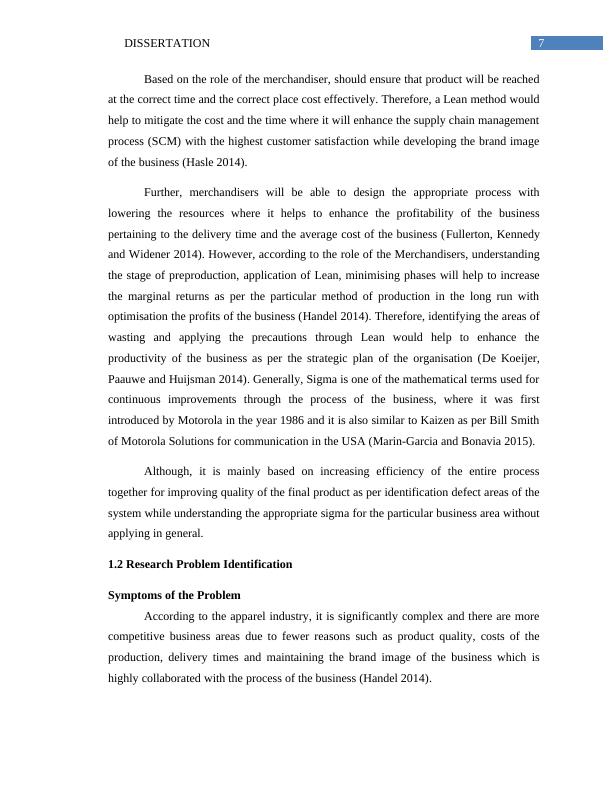
End of preview
Want to access all the pages? Upload your documents or become a member.
Related Documents
The Level of E-Training Readiness at Sultan Qaboos University: A Project Declaration of Originalitylg...
|43
|11083
|423
Customer Satisfaction in Online Shopping and Retail Industrylg...
|111
|25332
|82
The Case Study of Multichannel Marketing Used in Sports Directlg...
|58
|17687
|16
Understanding Factors that influence Impulse Buying in an onlinelg...
|49
|8896
|17
5 Years plan for anaesthetics service maintenance in houselg...
|41
|6731
|484
Using Derivatives for Hedging and increasing firm's value DISSERTATION SUPERVISOR: Dr. Ullas Rao Dissertatiolg...
|42
|14477
|389
